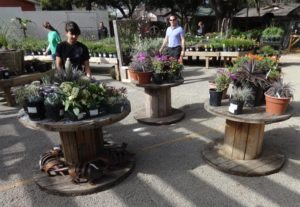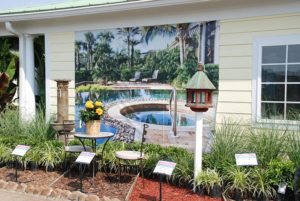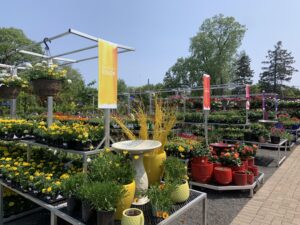The Ingredients For Making Outdoor Kitchens
Outdoor kitchens are becoming increasingly popular and making a tremendous mark on landscaping and life outdoors these days. The trend originated in the West, with the biggest markets in places like California, Arizona and Texas. Homeowners there are making elaborate outdoor living spaces that include entertainment systems and office areas. Of course, like most trends, outdoor kitchens first catered to the upscale market and over the years have reached the more mainstream homeowner.
Components of the outdoor kitchen range from permanent structures, more typically seen in indoor kitchens, to elaborate, portable grills. As the al fresco living trend continues, more people want to be outside, and having an outdoor kitchen increases the convenience of this lifestyle.
Convenience And Value
There is a wide range in outdoor kitchen styles. For pure convenience, portable appliances are the way to go. There is the standard outdoor grill that is now available in bigger models to allow for cooking more than just burgers. People are spending money on additional comforts from teak furniture to ice makers. More and more appliances are available for outdoor installation, and this tremendously increases the value of a home. Permanent outdoor kitchens can range from $3,000 to $15,000 and up. It’s all a matter of how many features and what price range a homeowner wishes to install. Typical components are grills, eating areas and counter and storage space.
Grill types are usually the basic charcoal or gas, though some models allow the user to switch between gas and charcoal. However, additional outdoor kitchen appliances can be as elaborate as ovens, side burners, wok burners and pizza ovens. Additional conveniences that can be included outdoors are storage cabinets, sinks, refrigerators and appliances tailored for cold-weather cooking. Due to the elements, stainless steel sinks are better for outdoor kitchens because they don’t corrode.
Refrigerators tend to be smaller units that fit under counters but range up to larger, more expensive models. If homeowners wish to extend the use of outdoor kitchens into cooler months, gas patio heaters are recommended. Typically, electric, water and gas lines can be brought outside from service inside the house to provide for the outdoor kitchen.
The Garden Center’s Role
The garden center is an important part of the planning and installation of the outdoor kitchen. According to Susan McCoy of the Garden Media Group, “New home owners are experiencing the frustration of wanting someone to plan their outdoor living space using interior design skills.” She strongly suggests that lawn and garden retailers invest in personnel with backgrounds in interior design to help customers plan and layout their outdoor living spaces, particularly kitchens.
Because a great deal of work is involved in installing a permanent outdoor kitchen, planning is necessary to making the best use of yard space and available budget. Homeowners need to plan around what sort of outdoor environment they want to foster. For instance, guests should be comfortable, and the homeowner shouldn’t have to look out the window at a pile of dirty dishes. The next step in determining the outdoor kitchen layout is to decide upon the number and type of amenities and appliances the customer wishes to include.
Planning And Design
With any major home improvement project, a good deal of planning and consideration is involved, and this is where the garden center steps in to help. There are many things to take into account when embarking on a project like installing a permanent outdoor kitchen; important steps include choosing the location, learning local zoning restrictions and planning for convenience. This is what the garden center can help inform its customer of before embarking on this project. Though you might not be an interior designer, you are an exterior designer so helping your customers add a few extras like a kitchen should be no problem when it comes to building the perfect backyard.
The shortest possible distance from the house is best. This cuts down on the back and forth of the host. Though, a homeowner should check zoning requirements to make sure the planned installation will be a legal distance from property lines. Because appliances may require gas, electricity or running water, routing for these needs to be incorporated into the design.
The outdoor kitchen should parallel the one indoors for functionality and comfort: Lighting is an important aspect to consider. Existing patios are often very well suited for outdoor kitchens, but watch out because overhead materials such as trees, trellises and patio roofs can be potential fire hazards.
The typical focal point for an outdoor kitchen is the grill, stove or oven. Counters, storage space, sinks and refrigerators are best arranged to make cooking easiest. One of the advantages of having an outdoor kitchen is being able to spend time with guests and not having to rush inside and out for food, plates, utensils and other things typically kept in the indoor kitchen. As such, the customer should also keep in mind how he or she wants to be oriented with respect to guests. Counter space and sitting areas should be arranged accordingly.
The outdoor kitchen should reflect the homeowner’s desires in both purpose and cooking style. Location and choice of equipment hinge on how the outdoor space will be used and what sort of food the homeowner plans to cook. Climate is an important consideration in choosing the nature of the materials and which appliances are suitable. Electrical appliances should be unplugged and stored during winter months in colder climates. Dining comfort comes into play when choosing dining furniture and incorporating it into the kitchen design. There should be enough room for everyone to eat comfortably.
Taking Advantage
With the advances in technology from appliances to heating, outdoor kitchens are becoming more and more pervasive. Al fresco living, as a culture, is becoming more popular. People are investing in their homes to increase its value and their convenience.
As a garden center, it is important to take advantage of this trend and tailor customer service to help homeowners plan and design outdoor kitchens. This will foster both sales and the likelihood of return customers. It’s yet another great way to develop a rewarding relationship with customers.

















 Videos
Videos





